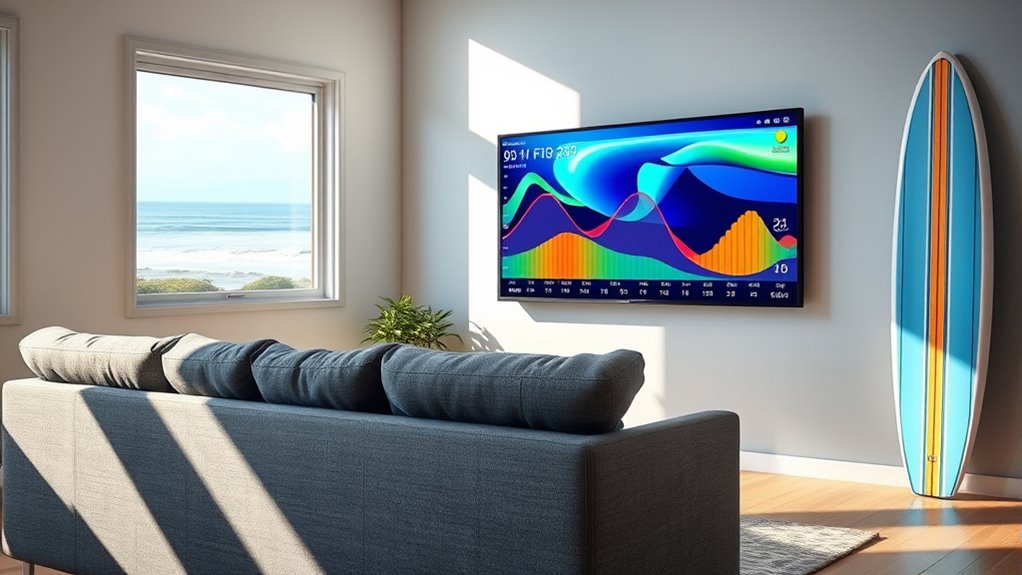To go from couch to a 10-foot wave, start by focusing on surf forecast charts that show wave height and swell direction. Wave height indicates how big the waves will be, helping you decide if conditions are beginner-friendly or challenging. Swell direction affects how waves break at your favorite spot. Local topography also plays a role in shaping the surf. By understanding these elements, you’ll be better prepared for your next surf session—keep exploring to learn more.
Key Takeaways
- Understand wave height indicators to gauge if conditions are suitable for your skill level, from small beginner waves to 10-foot surf.
- Learn how swell direction influences wave shape and breaking patterns at your local surf spot.
- Recognize how local topography interacts with swell to produce better or worse surf conditions.
- Use color-coded icons or numbers on charts to quickly assess wave size and plan your surf session.
- Consider wind and weather conditions alongside wave height and swell direction for optimal, safe surfing.

If you’re new to surfing, understanding how to read surf forecast charts can seem intimidating at first. But once you get the hang of it, you’ll find that they’re an invaluable tool for planning your sessions. The key elements to focus on are wave height and swell direction, as these directly influence the quality of your surf. Wave height, usually measured in feet or meters, tells you how big the waves are expected to be. Smaller waves might be perfect for beginners, while larger ones challenge even seasoned surfers. Swell direction indicates where the waves are coming from, which affects how they break and how suitable they are for your local breaks. For example, a swell coming from the south might create different wave patterns than one from the north, impacting your surf experience.
When you look at a forecast chart, you’ll notice the wave height is often represented by color-coded icons or numbers. The numbers show the expected height, helping you determine if the surf will be manageable or too powerful for your skill level. As a beginner, you’ll generally want to aim for wave heights between one to four feet, with the occasional larger set waves for more experienced days. Pay attention to swell direction too—this influences the wave shape and how it wraps around the coastline or reef. Knowing the swell direction helps you pick the right spot to surf; some beaches work better with certain swell directions, producing cleaner, more rideable waves.
Understanding local topography and how it interacts with swell conditions can significantly improve your surf planning and experience. Reading these charts also involves understanding how swell size and direction interact with local topography. For example, a beach that’s exposed to a particular swell direction will usually have better, more consistent waves when the swell is coming from that direction. Conversely, if the swell is from an unfavorable direction, the waves might be disorganized or break further out, making it less ideal for beginners. Keep in mind that weather conditions, such as wind, also affect wave quality, but wave height and swell direction are your main indicators for what to expect in the water.
Frequently Asked Questions
How Accurate Are Surf Forecast Charts Overall?
You might wonder how accurate surf forecast charts are, and it varies. Wave height variability can be unpredictable, but forecast model accuracy has improved over years thanks to better data and technology. While forecasts give you a solid idea of upcoming conditions, always consider local factors and real-time updates. Overall, they’re fairly reliable, but staying flexible and checking multiple sources helps you catch the best surf.
Which Charts Are Best for Beginners?
As a beginner, you should start with simple surf forecast charts that highlight surf spots and tide charts. Look for ones that clearly show wave height, swell direction, and tide times, making it easier to understand current conditions. These charts help you plan your sessions better, ensuring you hit the waves at the right time and place. Focus on user-friendly options that provide detailed, easy-to-read info for a smoother learning curve.
How Often Are Surf Forecasts Updated?
You’ll find surf forecasts are usually updated several times a day, often every 6 to 12 hours. This keeps wave height and swell direction information current, helping you plan your surf sessions better. By checking these updates regularly, you can track changes in wave height and swell direction, ensuring you’re riding the best conditions possible. Staying attentive to forecast updates helps you catch the perfect wave and stay safe in the water.
Can Weather Changes Affect Forecast Reliability?
Weather changes can turn your surf forecast into a shifting tapestry, making it less reliable. Climate variability and seasonal patterns act like the ocean’s mood swings, influencing wave conditions unexpectedly. Sudden storms or shifts in wind can disrupt forecasts, so it’s wise to stay flexible. Keep an eye on real-time updates and trust your instincts—weather’s whims are part of the surfing adventure, not a flaw in the forecast.
What Equipment Is Needed to Read Forecast Charts?
To read surf forecast charts effectively, you need a few key tools. A surf map helps you visualize wave patterns, while swell charts show you the expected size and direction of waves. You should also have a good understanding of symbols and color codes on these charts. A reliable internet connection or printed charts are essential, so you can quickly access and interpret the data before heading out to surf.
Conclusion
Now, as you stand on the sandy shore, imagine spotting that perfect swell rolling in, each wave building taller and more inviting. With your newfound knowledge of surf forecast charts, you’re ready to read the signs the ocean gives. Feel the anticipation ripple through you like the tide itself, guiding you from the couch to catching your first 10-foot wave. Trust your skills, embrace the adventure, and let the ocean become your ultimate playground.










